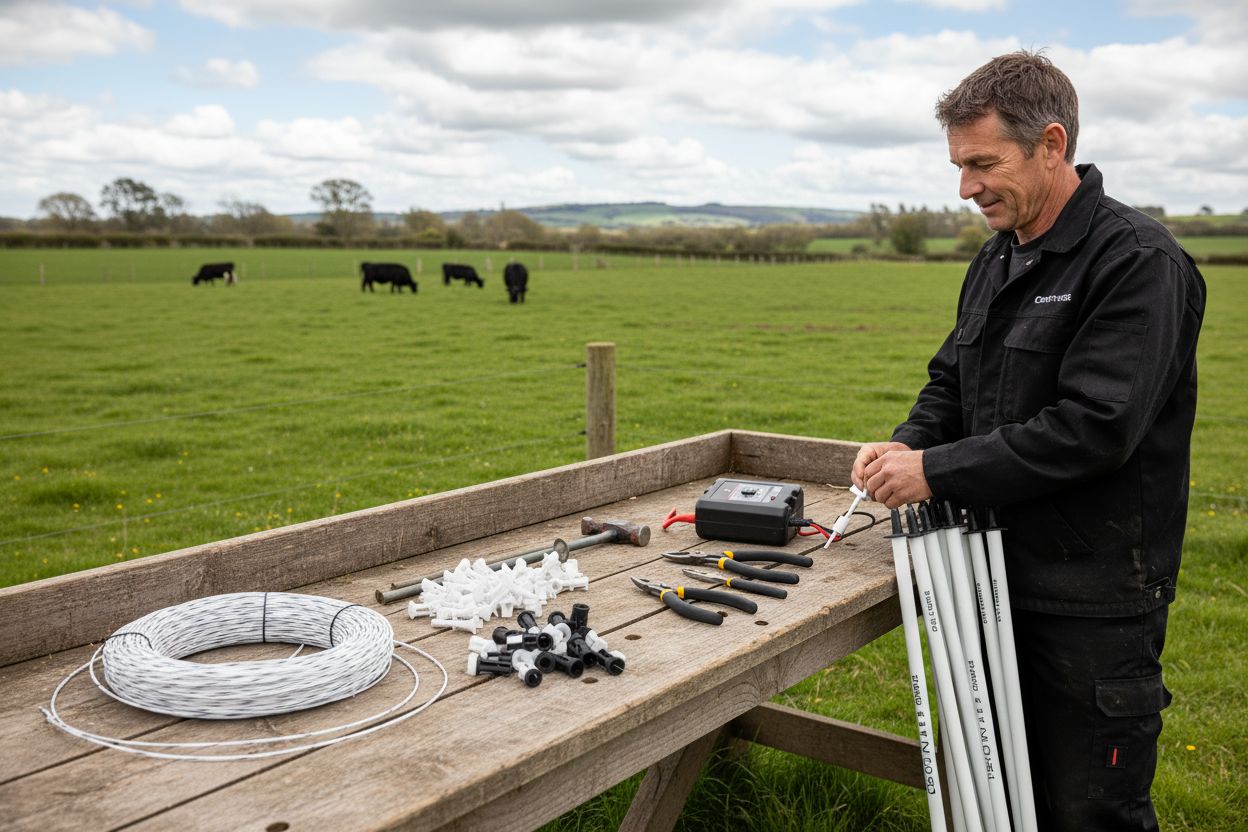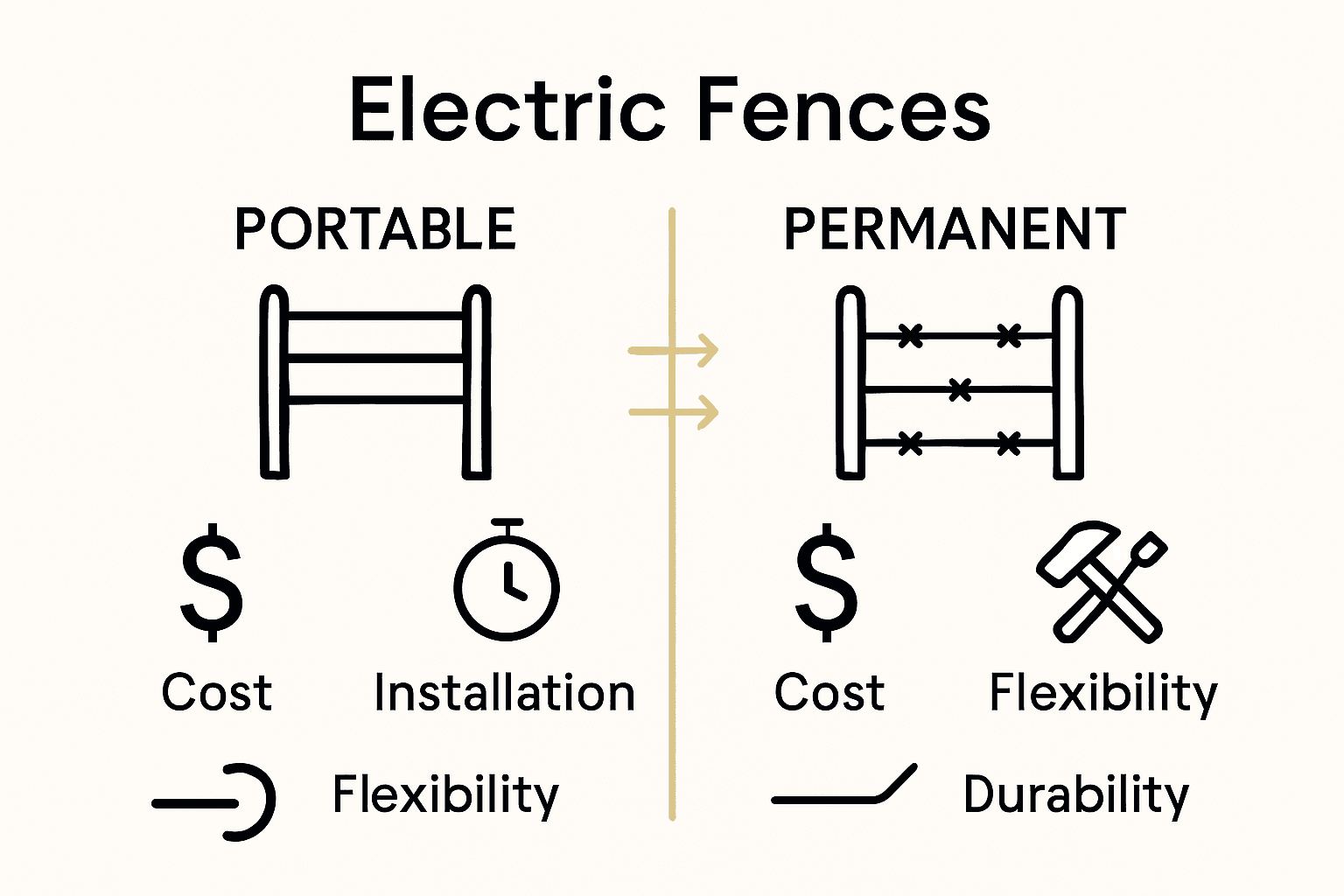Did you know that well-installed portable electric fences can reduce livestock escapes by up to 90 percent compared to traditional barriers? For many farmers, keeping animals safe while allowing for flexible pasture management is both a challenge and a priority. Discover how portable electric livestock fencing combines ease of use, reliability, and humane livestock control, giving you adaptable solutions that work even as your farming needs change.
Key Takeaways
| Point | Details |
|---|---|
| Portable Electric Fences | They offer a flexible, cost-effective solution for managing livestock with quick setup and relocation capabilities. |
| Psychological Deterrence | These fences operate by using electrical pulses that condition animals to respect boundaries without causing lasting harm. |
| Maintenance and Safety | Regular inspection and proper setup are crucial to ensure effectiveness and safety in preventing electrical shorts or injuries. |
| Comparative Advantages | Portable systems provide flexibility and lower upfront costs, while permanent fences offer durability and structural integrity. |
Table of Contents
- What Is A Portable Electric Livestock Fence?
- Types Of Portable Electric Fencing Systems
- How Portable Electric Fences Work For Livestock
- Key Setup Requirements And Best Practices
- Safety Precautions And Common Mistakes To Avoid
- Comparing Portable Fence Vs. Permanent Systems
What Is a Portable Electric Livestock Fence?
A portable electric livestock fence is an innovative and flexible containment system designed to provide farmers and ranchers with a lightweight, adaptable solution for managing livestock movement and protection. According to research from agricultural sources, these fences operate as psychological barriers that effectively control animal boundaries through strategic electrical deterrence.
Unlike traditional fixed fencing, portable electric livestock fences rely on an energizer that delivers high-voltage but non-lethal electrical pulses through lightweight components like polywire and temporary insulating posts. Our guide on understanding electric fence basics reveals that these systems work by creating a memorable shock experience that trains animals to respect boundary limits without causing permanent harm.
Key features of portable electric livestock fences include:
- Lightweight and easily transportable design
- Quick setup and relocation capabilities
- Psychological deterrence through electrical pulses
- Minimal physical infrastructure requirements
- Cost-effective compared to permanent fencing solutions
The primary mechanism of these fences is teaching livestock to associate the boundary with a brief, startling electrical sensation.
 Once animals learn the fence’s limits, they typically avoid crossing the boundary, making portable electric fences an intelligent and humane livestock management tool for farmers seeking flexible containment options.
Once animals learn the fence’s limits, they typically avoid crossing the boundary, making portable electric fences an intelligent and humane livestock management tool for farmers seeking flexible containment options.
Types of Portable Electric Fencing Systems
Portable electric fencing systems have evolved significantly, offering farmers and ranchers multiple innovative solutions for livestock management. These systems range from traditional wire-based setups to cutting-edge technological approaches that provide flexible and efficient containment strategies.
Traditional Polywire Systems remain the most common portable electric fencing option. These lightweight systems use plastic wire infused with conductive metal strands, supported by temporary insulating posts that can be quickly repositioned. Our guide on understanding electric fence basics highlights their versatility for rotational grazing and temporary pasture management.
More advanced portable electric fencing technologies include:
Here’s a comparison of key portable electric fencing system types:
| System Type | Visibility | Durability | Best For |
|---|---|---|---|
| Polywire | Moderate | Lightweight | Rotational Grazing |
| Tape Fencing | High | Moderate | High Animal Detection |
| Rope Fencing | Moderate | Strong | Large Livestock |
| Virtual Fencing | Not visible (virtual) | No wear on wire | Tech-driven Management |
- Tape Fencing: Wider and more visible than polywire, offering better animal detection
- Rope Fencing: Stronger and more durable for larger livestock
- Virtual Fencing Systems: Innovative GPS-based technologies
According to recent research, virtual fencing systems represent the most technologically advanced portable containment method.
As documented by Wikipedia’s nofence documentation, these systems use GPS-enabled collars that deliver audio warning tones and mild electric impulses, allowing ranchers to adjust livestock boundaries without physical wiring. For reliable solar energizer setups that power these systems, modern farmers can now manage livestock boundaries with unprecedented flexibility and precision.
How Portable Electric Fences Work for Livestock
Portable electric fences operate on a sophisticated yet simple electrical containment principle that leverages animals’ natural learning responses. The core mechanism involves an energizer that sends periodic electrical pulses through a conductive wire or tape, creating a psychological and physical barrier for livestock. Our comprehensive guide on electric fences for livestock explains the intricate workings of these systems.
According to specialized agricultural research, the energizer delivers short, sharp electric pulses through the conductor wire. When an animal touches the electrified wire, the energy is conducted through the animal’s body into ground rods, completing an electrical circuit. This brief, startling shock creates a powerful deterrent that teaches livestock to respect boundary limits without causing lasting harm.
The electrical system’s effectiveness relies on several key components:
- Energizer: Generates controlled electrical pulses
- Conductor Wire/Tape: Transmits electrical current
- Ground Rods: Complete the electrical circuit
- Insulators: Prevent unintended electrical discharge
The psychological impact of these fences is remarkable. Animals quickly learn to associate the fence with the brief, uncomfortable shock, developing a conditioned response that prevents future boundary crossings. This training occurs rapidly, making portable electric fences an intelligent and humane livestock management solution that offers farmers unprecedented flexibility in pasture and herd control.
Key Setup Requirements and Best Practices
Successful portable electric livestock fencing requires careful planning and strategic implementation. Proper setup is crucial to ensuring the effectiveness and safety of your electric fence system, with multiple critical considerations that can make or break your containment strategy. Our comprehensive guide to electric fence basics provides additional insights into creating robust livestock management solutions.
The foundation of an effective portable electric fence starts with selecting the right energizer and power source. Farmers must consider factors like pasture size, livestock type, and terrain when choosing between battery, solar, or plug-in energizers. Proper grounding is equally critical - inadequate ground systems can significantly reduce the fence’s effectiveness, potentially rendering the entire setup ineffective.
Key setup requirements include:
- Voltage Consistency: Maintain 2000-4000 volts for optimal livestock deterrence
- Ground Rod Installation: Use multiple 6-8 foot ground rods spaced 10 feet apart
- Regular Voltage Checks: Test fence voltage weekly using a reliable voltage tester
- Clear Vegetation: Maintain vegetation-free zones around fence lines
- Strategic Post Placement: Space posts 40-50 feet apart for maximum stability
Practical considerations extend beyond initial installation. Regular maintenance, including checking for shorts, replacing worn components, and ensuring consistent electrical current, is essential for long-term success. By following these best practices, farmers can create a reliable, flexible, and humane livestock containment system that adapts to changing pasture management needs.
Safety Precautions and Common Mistakes to Avoid
Portable electric livestock fencing requires meticulous attention to safety protocols to protect both animals and farmers. Electrical system management demands comprehensive understanding and proactive prevention strategies. Our comprehensive electric fence guide emphasizes the critical importance of implementing robust safety measures.
According to agricultural research, one of the most significant risks involves improper electrical system configuration. As documented by agricultural experts, farmers must avoid using conducting steel posts without proper insulation, which can create dangerous electrical shorts. Selecting high-quality, durable insulators and maintaining precise energizer settings are fundamental to preventing accidental breaches or potential livestock injuries.
Common mistakes to avoid include:
- Inadequate Grounding: Insufficient ground rod installation
- Poor Voltage Regulation: Inconsistent electrical current
- Vegetation Interference: Allowing overgrowth near fence lines
- Improper Insulator Selection: Using low-quality or damaged insulators
- Lack of Animal Training: Failing to properly introduce livestock to fence boundaries
Additional critical safety considerations involve regular system inspections, maintaining clear perimeters, and ensuring that all components remain in optimal condition. By understanding these potential pitfalls and implementing comprehensive safety protocols, farmers can create a secure, effective portable electric fencing system that protects both their livestock and their investment.
Comparing Portable Fence vs. Permanent Systems
Livestock management demands strategic fencing solutions, and farmers must carefully evaluate the trade-offs between portable electric fences and traditional permanent systems. These two approaches offer distinctly different advantages that can significantly impact farm operations, animal management, and long-term agricultural productivity. Our comprehensive guide to livestock fencing solutions provides deeper insights into these critical considerations.
Portable electric fences excel in flexibility and cost-effectiveness, allowing farmers to quickly reconfigure pasture layouts, implement rotational grazing strategies, and adapt to changing landscape conditions. Permanent systems, by contrast, provide more robust, long-term boundary definitions with greater structural integrity. The choice between these approaches depends on multiple factors including farm size, livestock type, terrain complexity, and management objectives.
Key comparative aspects include:
- Initial Investment: Portable systems require lower upfront costs
- Installation Time: Portable fences can be deployed rapidly
- Flexibility: Easy reconfiguration with portable options
- Durability: Permanent systems offer longer-lasting infrastructure
- Maintenance Requirements: Portable fences demand more frequent component replacement
Ultimately, many modern farmers are adopting hybrid approaches that combine the strengths of both portable and permanent fencing. By understanding the unique benefits of each system, agricultural professionals can design comprehensive livestock management strategies that maximize efficiency, animal welfare, and operational adaptability.

Take Control of Your Livestock Boundaries With FenceFast.ca
If you are struggling with the challenges of unpredictable livestock movement, unreliable fencing setups, or the stress of frequent repairs, FenceFast.ca is ready to help you build a safer, more efficient grazing solution. Portable electric livestock fences offer flexible protection and easy management, but success depends on having the right parts and support. Our selection answers the exact issues highlighted in this article, from ensuring voltage consistency to finding reliable connectors and posts. You deserve peace of mind, knowing your animals are secure no matter how often you move your boundaries.

Do not wait until your herd tests the limits of an old setup. Discover how FenceFast.ca makes upgrading your livestock containment simple with proven electric fencing products, energizers, and accessories, plus expert advice for every stage. Shop now and get fast nationwide delivery. If you need guidance matching systems to your animals or acreage, contact us for a custom solution or visit our homepage to get started with your next fencing project.
Frequently Asked Questions
What is a portable electric livestock fence?
A portable electric livestock fence is a flexible containment system designed to manage livestock movement using lightweight components and electrical pulses. It serves as a psychological barrier that trains animals to respect boundary limits without causing permanent harm.
How do portable electric fences work for livestock management?
Portable electric fences operate by sending short electrical pulses through a conductive wire or tape, creating a psychological deterrent for livestock. Animals learn to associate the fence with a brief shock, quickly developing a conditioned response to remain within the designated boundaries.
What are the main types of portable electric fencing systems?
The main types of portable electric fencing systems include traditional polywire, tape fencing, rope fencing, and more advanced virtual fencing systems. Each type varies in visibility, durability, and application suitability depending on the livestock and pasture management needs.
What are some best practices for setting up a portable electric fence?
Key best practices for setting up a portable electric fence include maintaining voltage consistency (2000-4000 volts), ensuring proper grounding with multiple ground rods, regular voltage checks, keeping vegetation clear around fence lines, and strategically spacing posts 40-50 feet apart for stability.
